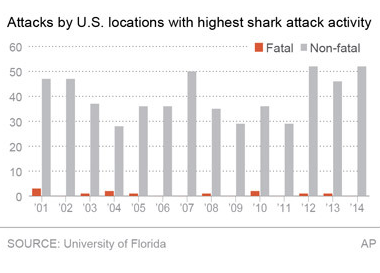WASHINGTON — It’s the time of year to roll out the beach blanket, plant the umbrella and dash into the ocean water. But after seven reported shark attacks along the Carolina coast this month, beachgoers should take precautions when they hit the shore this summer.
“There appears to be some environmental things going on. The waters are warmer than usual … the salt content is higher and there are big schools of fishes near the shoreline and that’s very attractive to sharks,” says George Burgess, director of the Florida Program for Shark Research and International Shark Attack File for the Florida Museum of Natural History.
But Burgess says increasing numbers of beachgoers also help swell statistics of human-shark encounters.
“North Carolina, as many other states around the south, have had increased tourism over the last 30 or 40 years. And now we’re simply putting more people in the water so we can expect more incidents,” Burgess says.
 Nat Geo Wild — promoting its upcoming weeklong Shark Fest — has identified the top five states for shark attacks.
Nat Geo Wild — promoting its upcoming weeklong Shark Fest — has identified the top five states for shark attacks.
Florida leads the list with 219 encounters over ten years, followed by Hawaii with 55, California with 31, South Carolina with 38 and North Carolina with 25.
Burgess says Florida’s extraordinarily long coast line contributes to the high number of shark attacks there, in addition to warm water temperatures.
“Obviously we’re in tropical and subtropical waters, which means the waters are warm year-round, which means people can go in the water,” Burgess says.
The Florida Museum of Natural History estimates that the odds of a shark attack are one in 11.5 million.
“Most of the time we come out of the water without a scratch … but, each year there are about six deaths that occur worldwide,” Burgess says.
How to stay safe at the beach from sharks
Burgess has tips for beachgoers to help them avoid becoming a statistic.
“Most important things we can do to reduce shark encounters would be, first of all, staying out of the water between dusk and dawn, which are time periods when sharks are more active feeding. Sticking together in groups would be important because sharks tend to go after solitary prey,” Burgess advises.
It’s also wise to stay out of spots where sharks might congregate, like near their food sources.
“Avoid inlets, channels, the troughs between sandbars and the surf zone. Those are areas where their food items concentrate and where sharks can be found,” Burgess says.
Other tips to avoid getting attacked by a shark include:
- Don’t wear shiny jewelry as it catches the shark’s eye.
- Refrain from excessive splashing.
- Look out for signs of bait fish used by commercial fishermen, schools of fish or other feeding activity. Diving seabirds target such areas.
- Don’t go in the water if sharks are known to be present. Leave the water if sharks are sighted.








